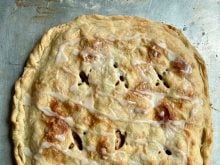My friend Beth dropped over with a magazine article entitled Try a Little Bread Therapy. She agreed with it because she bakes all her own bread.
Her grown children still comment about how wonderful it was to come home from school and be met by the aroma of fresh baked bread. They could smell it even before they reached the house. Beth said she feels sorry for children who never have this experience.
In part, this article said: “There is nothing quite as comforting as the smell of baking bread – except perhaps a warm slice slathered in butter and drizzled with honey.
Read Also

From farmer to award-winning distiller
Pivot Spirits showcases transition from farmer to distiller with provincial award-winning results in Alberta for Lars Hirch
“Bread making is as much about the process as it is about the end result. The rhythmic kneading of a ball of dough puts hands and arms in motion, opens the lungs and rib cage for deeper breathing and focuses the mind on the task of creating something worthwhile and nourishing. It is easy to learn and the more you make bread, the better it will be.
“Bread making is good therapy. You can take out your stress while kneading the dough, you can centre yourself while it rises, and you can nourish yourself and those you love with a finished loaf.”
The article invites all of us to make our own bread, even if we have never tried it before. All we really need is a pair of willing hands, an oven, a few basic ingredients and patience. Beth and I would agree you should give it a try.
Try a bread recipe from your favourite cookbook, from the website www.breadworld.com or this raisin bread recipe that I occasionally make.
Raisin bread
41/4-41/2 cups all-purpose 1-1.12 L
or bread flour
1/4 cup powdered milk 60 mL
1/4 cup sugar 60 mL
1 tablespoon quick-rise yeast 15 mL
1 teaspoon cinnamon 5 mL
2 teaspoons salt 10 mL
11/4 cups very warm water 310 mL
1/4 cup softened butter 60 mL
or margarine
2 eggs, beaten
1 cup raisins 250 mL
In a large bowl, combine two cups (500 mL) of the flour with the other dry ingredients (powdered milk, sugar, yeast, cinnamon and salt).
Stir in the water, along with the butter.
Add the eggs and beat with a mixer or a spoon until smooth. Add the raisins.
Continue stirring and adding flour until the dough forms a ball and leaves the sides of
the bowl.
Knead dough on a lightly floured board five to 10 minutes until it is no longer sticky. Cover and let rest for 10 minutes.
Divide dough in half. Shape into loaves. Place in greased nine x five inch (22 x 12 cm) loaf pans.
Let rise in a warm place until dough doubles in size and reaches the top of the pan with the corners filled, about one to 1 1/2 hours.
Bake in 375 F (190 C) oven for 35 to 40 minutes. When loaves have baked, brush with a glaze of two tablespoons (30 mL) sugar mixed with two tablespoons (30 mL) water. Makes two loaves
Note: When using quick-rise or instant yeast, it is important that the water be very warm at 120 to 130 F (50 to 55 C). For best results, use a thermometer to gauge the temperature of the water.
Tapioca frog-eye salad
Dear TEAM: In your Sept. 22, 2005 issue, you were asked for a frog-eye salad, and you replied with a recipe using acini de pepe, a pasta. I believe the lady asked for a tapioca salad. Could it be the following? – V.T., Warman, Sask.
Dear V.T.: Thanks so much for sending the tapioca version of a frog-eye salad. Yes, I believe that is what was wanted, but I only could find recipes using the pasta instead of tapioca. Now we have the tapioca version. Thanks.
1 cup tapioca 250 mL
21/2 cups milk 625 mL
1 cup sugar 250 mL
1 teaspoon vanilla 5 mL
1 can (28 oz.) fruit cocktail 796 mL
grapes and strawberries,
if available
1 large tub (4 cups) whipped 1 L
topping or whipped cream
Soak tapioca. The large needs overnight and the small needs only two hours.
Cook the tapioca in the milk until the tapioca is soft and transparent. Add sugar and vanilla and cook three to five minutes more. Cool. Add the fruit cocktail, grapes and
strawberries.
Fold in the whipped topping. Chill.
Keeps well for five or six days.
Recipe request
L.G., Aberdeen, Sask., has lost a shepherd’s pie recipe that she really liked. She thinks it was printed in Emmie Oddie’s column in the mid-1980s. What was special about this recipe is that it had potatoes and parsnips in the topping. Other ingredients were carrots, celery, beef broth and ground beef. Does anyone have this recipe?
Broth recipe
Dear TEAM: I had a real good recipe for vegetable broth but have misplaced it. It was delicious with rice. It had tomatoes, carrots, celery and onion in it. I can’t remember what else or for how long I cooked it. – C.G., Neepawa, Man.
Dear C.G.: There are many different recipes for vegetable broth. Basically, they all boil a variety of vegetables in water, then strain it and cool.
Ann Lindsay in her cookbook, Lighthearted Everyday Cooking, suggests the following:
For a vegetable stock, save vegetable scraps like onion skins, tomato, carrot, parsley stems, potato peelings, green bean strings and beet parts in a plastic bag in the freezer. Do not use brassica vegetables such as cabbage, broccoli, turnip and eggplant. When you have about half a saucepan full, cover with water. Bring it to a boil and simmer for 25 minutes. Strain stock, cool, cover and refrigerate.
The juices from canned or cooked vegetables, and with the water in which they are cooked, can be saved in a container in the freezer and used as a vegetable broth.
Some recipes saute the onions and some of the other vegetables like celery and carrots before adding to the pot with other vegetables.
The following recipe may be a guide for you in making a vegetable broth like the lost recipe you liked.
Vegetable broth
The vegetables in this stock don’t need to be peeled. Onion skins add colour to stocks and help keep them clear. Make a big batch and freeze it in small portions to use any time for perking up rice, gravies, mashed potatoes and much more.
10 cups water 2.5 L
4 thin-skinned potatoes,
scrubbed and halved
2 tomatoes, quartered
1 onion, quartered, unpeeled
2 leeks
2 carrots, unpeeled, scrubbed
2 celery ribs
2 cloves garlic, unpeeled
1 tablespoon fresh parsley 15 mL
1 teaspoon salt 5 mL
8 peppercorns
1 bay leaf
In a large stockpot, combine all the ingredients. Bring to a boil, reduce the heat and simmer, uncovered, for 90 minutes. Strain, removing all solids. Let cool. Keep in the refrigerator for up to three days or freeze for long-term storage. Makes eight servings.
Source: Adapted from www.cooksrecipes.com.
ClearJel
Dear TEAM: This is regarding ClearJel, for thickening pie fillings, from Kitchen Kraft, as mentioned in the Sept. 1, 2005, Western
Producer. I phoned the Iowa, U.S.A., number to order the product. The lady answering stated they were not contacted by the Western Producer, they don’t ship to Canada and it’s very expensive, $20 per lb. She stated they got several phone calls and actually seemed quite rude and annoyed by my call when I stated it’s written in the column at $3.25 a lb. Is there somewhere else where we can obtain the product? – B.K., Edson, Alta.
Dear B.K.: I was shocked to hear that the company did not ship to Canada when it told me it did. On further investigation, the company tells me it can ship to Canada. However, the shipping and handling is approximately $18.75 U.S. per lb.
The cost for the product listed on the website at www.kitchenkrafts.com is now $3.50 per lb. or $16.50 for five lb.
If you would still like to purchase the product, try again at the order desk, 800-776-0575. The customer service number is 800-298-5389 and the address is Kitchen Krafts, Box 442, Waukon, Iowa, U.S.A. 52172-0442. Messages can also be sent on the website. I haven’t been able to locate a Canadian supplier. Can
anyone help?
Regal Ware
For L.M., Weyburn, Sask., with the broken stainless steel pot, you can contact Regal Ware Inc., 1675 Reigle Dr., Kewaskum, Wis., U.S.A., 53040, 262-626-2121, www.regalware.com,
e-mail: cookware@regalware.com and include the model number and as much information as possible.
Alma Copeland is a home economist from Elrose, Sask., and one of four columnists comprising Team Resources. Send correspondence in care of this newspaper, Box 2500, Saskatoon, Sask., S7K 2C4 or contact them at team@producer.com.














